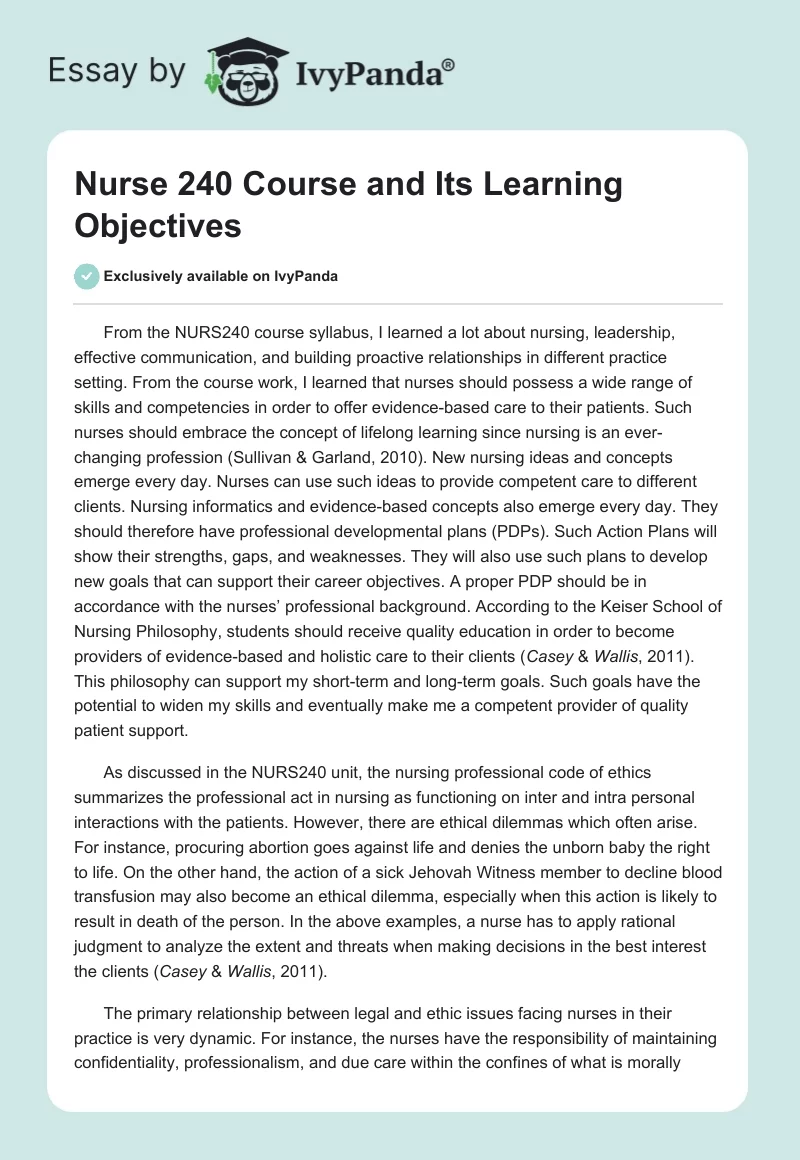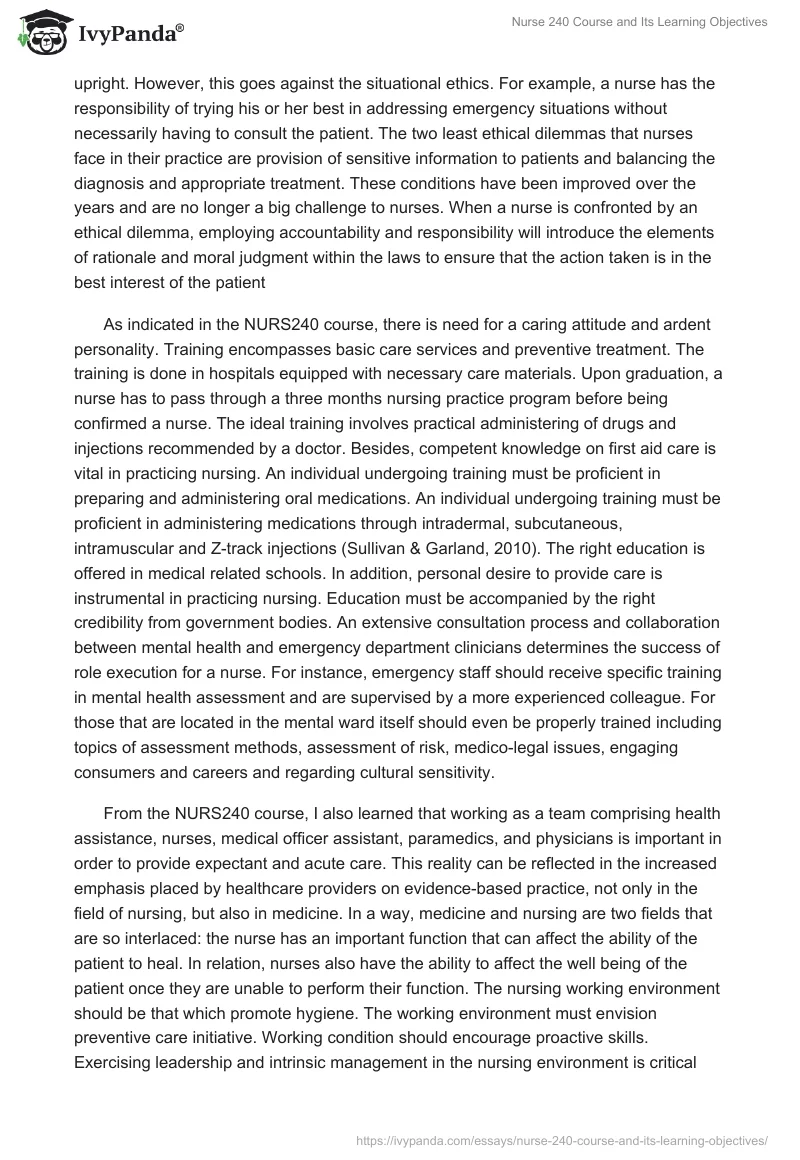From the NURS240 course syllabus, I learned a lot about nursing, leadership, effective communication, and building proactive relationships in different practice setting. From the course work, I learned that nurses should possess a wide range of skills and competencies in order to offer evidence-based care to their patients. Such nurses should embrace the concept of lifelong learning since nursing is an ever-changing profession (Sullivan & Garland, 2010). New nursing ideas and concepts emerge every day. Nurses can use such ideas to provide competent care to different clients. Nursing informatics and evidence-based concepts also emerge every day. They should therefore have professional developmental plans (PDPs). Such Action Plans will show their strengths, gaps, and weaknesses. They will also use such plans to develop new goals that can support their career objectives. A proper PDP should be in accordance with the nurses’ professional background. According to the Keiser School of Nursing Philosophy, students should receive quality education in order to become providers of evidence-based and holistic care to their clients (Casey & Wallis, 2011). This philosophy can support my short-term and long-term goals. Such goals have the potential to widen my skills and eventually make me a competent provider of quality patient support.
As discussed in the NURS240 unit, the nursing professional code of ethics summarizes the professional act in nursing as functioning on inter and intra personal interactions with the patients. However, there are ethical dilemmas which often arise. For instance, procuring abortion goes against life and denies the unborn baby the right to life. On the other hand, the action of a sick Jehovah Witness member to decline blood transfusion may also become an ethical dilemma, especially when this action is likely to result in death of the person. In the above examples, a nurse has to apply rational judgment to analyze the extent and threats when making decisions in the best interest the clients (Casey & Wallis, 2011).
The primary relationship between legal and ethic issues facing nurses in their practice is very dynamic. For instance, the nurses have the responsibility of maintaining confidentiality, professionalism, and due care within the confines of what is morally upright. However, this goes against the situational ethics. For example, a nurse has the responsibility of trying his or her best in addressing emergency situations without necessarily having to consult the patient. The two least ethical dilemmas that nurses face in their practice are provision of sensitive information to patients and balancing the diagnosis and appropriate treatment. These conditions have been improved over the years and are no longer a big challenge to nurses. When a nurse is confronted by an ethical dilemma, employing accountability and responsibility will introduce the elements of rationale and moral judgment within the laws to ensure that the action taken is in the best interest of the patient
As indicated in the NURS240 course, there is need for a caring attitude and ardent personality. Training encompasses basic care services and preventive treatment. The training is done in hospitals equipped with necessary care materials. Upon graduation, a nurse has to pass through a three months nursing practice program before being confirmed a nurse. The ideal training involves practical administering of drugs and injections recommended by a doctor. Besides, competent knowledge on first aid care is vital in practicing nursing. An individual undergoing training must be proficient in preparing and administering oral medications. An individual undergoing training must be proficient in administering medications through intradermal, subcutaneous, intramuscular and Z-track injections (Sullivan & Garland, 2010). The right education is offered in medical related schools. In addition, personal desire to provide care is instrumental in practicing nursing. Education must be accompanied by the right credibility from government bodies. An extensive consultation process and collaboration between mental health and emergency department clinicians determines the success of role execution for a nurse. For instance, emergency staff should receive specific training in mental health assessment and are supervised by a more experienced colleague. For those that are located in the mental ward itself should even be properly trained including topics of assessment methods, assessment of risk, medico-legal issues, engaging consumers and careers and regarding cultural sensitivity.
From the NURS240 course, I also learned that working as a team comprising health assistance, nurses, medical officer assistant, paramedics, and physicians is important in order to provide expectant and acute care. This reality can be reflected in the increased emphasis placed by healthcare providers on evidence-based practice, not only in the field of nursing, but also in medicine. In a way, medicine and nursing are two fields that are so interlaced: the nurse has an important function that can affect the ability of the patient to heal. In relation, nurses also have the ability to affect the well being of the patient once they are unable to perform their function. The nursing working environment should be that which promote hygiene. The working environment must envision preventive care initiative. Working condition should encourage proactive skills. Exercising leadership and intrinsic management in the nursing environment is critical towards handling different patient cases within the code of guideline for practicing nursing. Specifically, it is important to integrate the code of nursing practice with different environments to ensure that ethical dilemmas do not arise (Casey & Wallis, 2011).
The external factors which influenced my decision making and actions were the need for quality nursing care service within the accepted standards, and the need to take control as the charge nurse (Kulbok, Thatcher, & Meszaros, 2012). The internal factors which influence decision-making and actions are inspired by principles of nursing practice, sensitivity of the work environment, and team work through proactive leadership and professionalism. The main source of knowledge which influences nursing actions is the application of the evidence-based practice on SBAR. For instance, during my brief attachment in emergency room, I came across a patient who was put on a cardiac monitor and an ECG was done as the team and I awaited the A&E doctor. I had the alternative of directly taking the patient to resuscitation without applying the evidence-based SBAR practice. However, this alternative would attract ethical dilemmas such as poor observance of the standards for nursing practice and even death of the patient (Sullivan & Garland, 2010). The decision I made to facilitate stabilization of the patient was the most professional and necessary when responding to the emergency. Through the lens nursing leadership practice, I believe I made the best decision and took the most appropriate actions.
From the experience and the NURS240 course, I learned that it would be necessary to roll out patient-based initiatives for addressing the normative and comparative needs of the patient in the quickest way possible, especially in the emergency response environment. Besides, it is important to note that leadership inspires the need to contribute proactively towards creation of a suitable environment for closing the gap that may exist between a challenge and its solution (Kulbok et al., 2012). A nurse participating in a similar experience, as a charge nurse, may offer creative leadership which is a rich recipe for acceptance, sustainability, and relevance of the proposed stabilization or treatment from several alternatives.
The experience of stabilizing patient ABC was an eye opener into the critical factors to consider when delegating duties in the health care environment. Besides, I learned the importance of rationality and high quality decision making as the prerequisite for minimizing potential ethical dilemmas within an emergency response unit in a healthcare environment. As a result of properly structured communication ethics, the work environment was holistic, soft, and socially friendly to the staff since I applied valence in my leadership approach (Judith, Baile, & Docherty, 2011). Besides, healthy ethical communication culture between the team and I created structural goals which develop norms, expectations of specific behavior display, and appropriate guideline controlling interaction with one another. From this experience, I took it upon myself to ensure that whenever I am working with others, there is team involvement, proactive relationship, and professional association as the blueprint for quality service delivery to patients (Hornby & Atkins, 2013). From this experience, I have improved on my knowledge in nursing practice on the best ways of employing accountability and responsibility as the elements of rationale and moral judgment within the laws to ensure that the action taken is in the best interest of the patient.
As indicated in the theory of human caring, the character and values that have a positive impact on leadership nursing practice include confidentiality, rationality, good communication, high morals, respect, and promotion of equality as part of the helping relationships. Basically, these elements form the strength of a successful nursing leadership career. On the other hand, social relationships deal with positive ethical aspirations within the rational leadership model to ensure that the interaction between nurses is healthy. This model is supported by experience of the individual in question since performance and ethical decision making process is skewed towards experience with a situation (Fielding & Briss, 2012). The ethical aspirations which were achievable through action oriented respect, mutual coexistence, and deeply entrenched social values, which are vital in rational decision making. These values were readiness and inclination to jump into actions which considered the morality of the decisions to me, the team, and most importantly to the patient.
Apparently, perception review offers the most ethically viable option for proactive leadership management of behavior in the health care environment as part of social relationships. This identifies the aspects of effort-performance expectancy, valence expectancy, and performance-outcome expectancy. The nurses have the responsibility of maintaining confidentiality, professionalism and due care within the confines of serving the best interest of the patient as part of the helping relationships. Through application of the evidence-based SBAR practice, a nurse is able to follow the guideline in delegating duties, alerting the doctor, explain the patient’s condition. Exercising leadership in the nursing environment is critical towards handling different cases within the guidelines for practicing nursing (Casey & Wallis, 2011). From the course unit, I learned that it would be necessary to roll out goal based initiatives for addressing the normative and comparative needs in the quickness way possible. Apparently, perception analysis offers the most ethically viable option for proactive leadership management of behavior in the health care environment.
References
Casey, A., & Wallis, A. (2011). Effective communication: principle of nursing practice. Nursing Standard, 25(32), 35-37.
Fielding, J., & Briss, P. (2012). Promoting evidence-based public health policy: Can we have better evidence and more action? Health Affairs Journal, 5(4), 969-978.
Hornby, S., & Atkins, J. (2013). Collaborative care: inter-professional, inter-agency and inter-professional. Oxford: Blackwell Publishing.
Judith, A., Baile, E., & Docherty, S. (2011). Nursing roles and strategies in end-of-life decision making in acute care: A systematic review of the literature. Nursing Research and Practice, 2(5), 45-67.
Kulbok, P., Thatcher, E., & Meszaros, P. (2012). Evolving public health nursing roles: Focus on community participatory health promotion and prevention. The Online Journal of the American Nurses Association, 17(2), 12-38.
Sullivan, E., & Garland, G. (2010). Practical leadership and management in nursing. London, UK: Pearsons Education.


